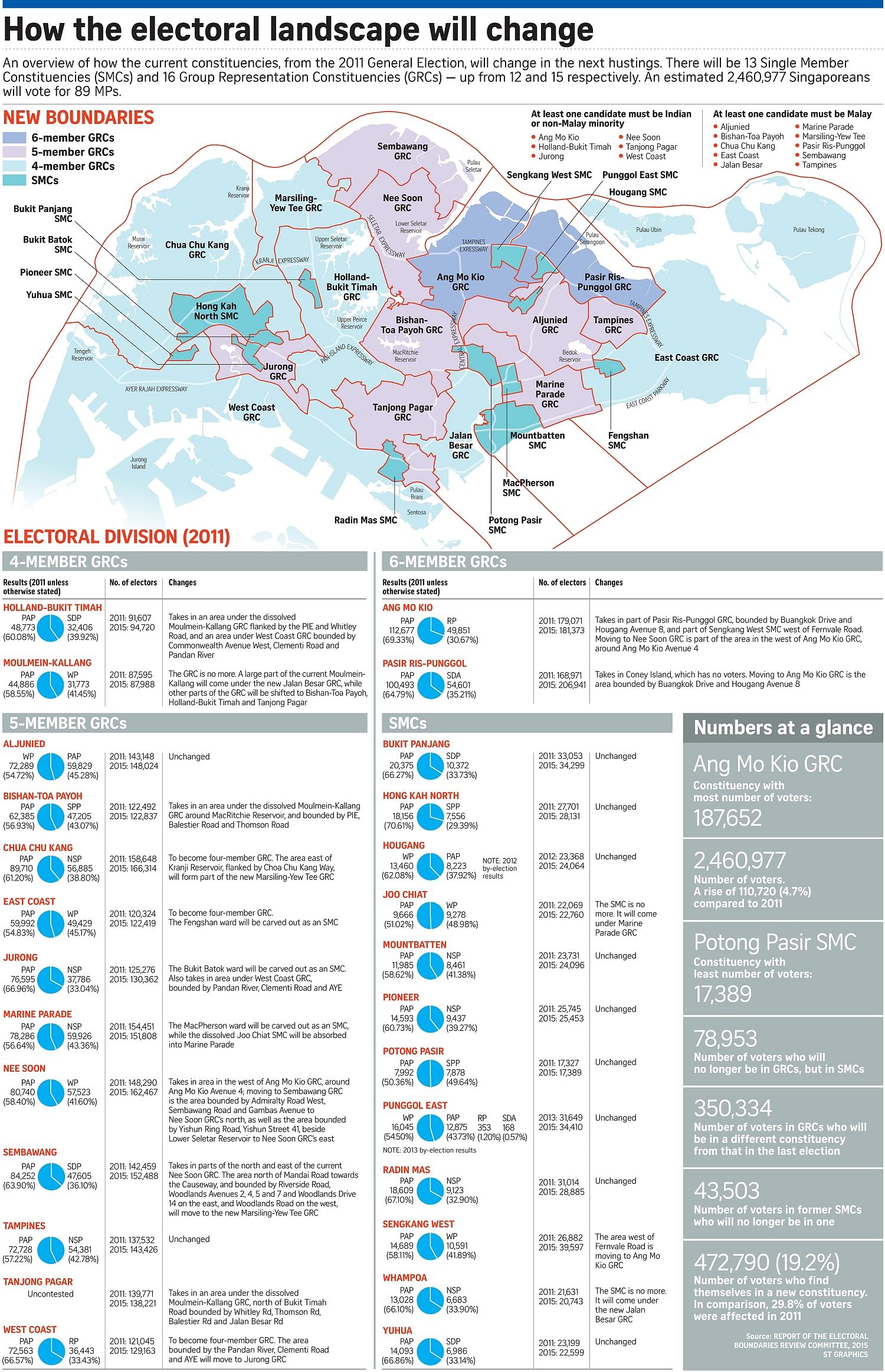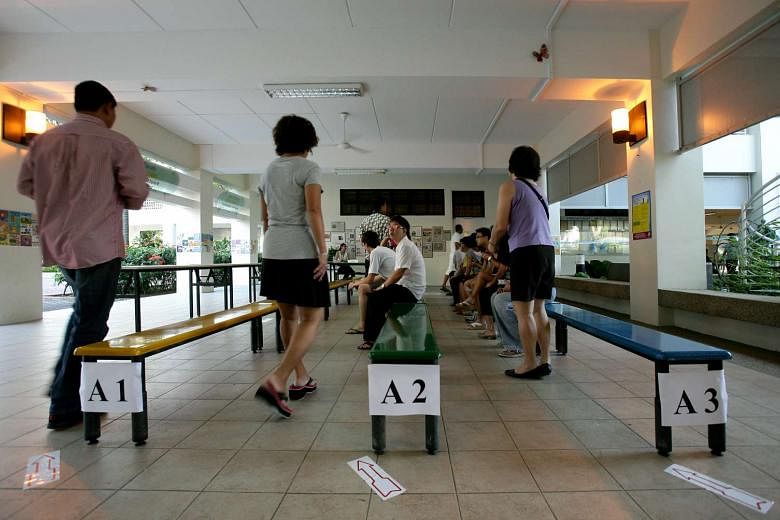The Electoral Boundaries Review Committee released its much-awaited report yesterday, a document that will be pored over for what it says about the political landscape and the coming election.
But in truth, its 14-page report, full of tables giving number of voters in each constituency, was fairly unremarkable.
Its most remarkable decision comes in the form of a small but potent bombshell. Joo Chiat Single Member Constituency has disappeared, swallowed by People's Action Party stronghold Marine Parade GRC. In the 2011 General Election, Workers' Party (WP) candidate Yee Jenn Jong had garnered 48.99 per cent of votes.
So what explains this move?
With 22,752 voters (based on April figures), Joo Chiat is a tad small, since the average number of voters per constituency is 28,300, for an electorate of 2.46 million and 87 constituencies.
But the boundaries committee also allowed a plus/minus 30 per cent variation in number of voters per seat, which it said would yield 20,000 to 37,000 voters per MP. Joo Chiat's estimated 22,752 voters falls within this range.
So if Joo Chiat's population changes do not warrant a change in boundary, what does?
Asked for his views on the change, Mr Yee declined to speculate about any political motivation for the change. Instead, he said he thought Joo Chiat residents too would be disappointed: "Even people who have voted for the PAP... are also looking forward to a close fight."
Many observers would attribute the ward's disappearance to politics. Yet, as veteran political watcher Hussin Mutalib noted, opposition strongholds like Aljunied GRC, Hougang and Punggol East were left largely untouched, as was hotly contested Potong Pasir.
Concerns that the boundary changes would severely disadvantage the opposition were not realised, he said, adding: "In this sense, probable accusations of bias and unfairness will be muted."
So optimists may say this year's report could have been much worse. As analyst Lam Peng Er put it: "2015 is actually not too bad, I don't think the opposition should kick up too much of a fuss."
Since 2006, dramatic boundary changes common in the 1990s have been done away with. Instead, small shifts to electoral boundaries are more common.
In 2011, despite widespread speculation, hot seat Aljunied GRC was left intact and the WP won it. The committee's terms of reference in any case are technical, not political: to review constituency boundaries in a way that "take into consideration significant increases or decreases in the number of electors in the current electoral divisions as a result of population shifts and housing developments since the last boundary delineation exercise".
Some changes would appear logical from that population point of view. Woodlands, where new homes are being constructed, yields a new GRC in Marsiling-Yew Tee. If you look at the overall electoral map of 2015 now, single- seat constituencies are concentrated around the western and north-eastern fringes: Pioneer, Bukit Batok, Bukit Panjang, Hong Kah North in the west; and Punggol East and Sengkang West in the north-east. This is consistent with the west and north-east being areas of high population growth over the last decade, as new housing estates mushroom.
But if you look at the individual changes one by one, it is impossible to figure out if politics or population changes were the driving factor.
Neighbouring Moulmein-Kallang GRC, which the PAP held on to with 58.6 per cent of the votes in 2011, has been carved up with a large portion going to Bishan-Toa Payoh GRC. But it was not the worst-performing GRC for the incumbent. A new GRC named Jalan Besar has been formed, harking back to 2006 when Jalan Besar GRC existed.
With Moulmein-Kallang GRC gone, speculation will be rife as to what this means for the two ministers anchoring it: Transport Minister Lui Tuck Yew, beset by SMRT breakdown woes; and Minister for Communications and Information Yaacob Ibrahim.
Mr Lui said on Facebook he was disappointed but understood why the changes had to be made: "PM has given the guidelines to the boundaries committee to have smaller GRCs, and you need to create more GRCs, smaller GRCs, so naturally the boundaries will have to shift."
In this respect, opposition candidate Tan Jee Say noted that the Government had promised to reduce the size of GRCs. But there are no three-member GRCs. Meanwhile, two GRCs continue to have six MPs: Ang Mo Kio and Pasir Ris-Punggol. He said: "They promised a lot of things, but it didn't really come about."
Overall, the increase in GRCs from 15 to 16 means there will be one more minister needed to "helm" a GRC.
Will one of the two young ministers Lawrence Wong or Tan Chuan-Jin move out from beneath the "coat-tails" provided by their anchor ministers in, respectively, West Coast GRC (Lim Hng Kiang) and Marine Parade GRC (Goh Chok Tong)? After all, their political peer Chan Chun Sing is likely to anchor Tanjong Pagar GRC in the next election, with the death of Mr Lee Kuan Yew in March.
Three new single seats were carved out: Fengshan, Bukit Batok and MacPherson. With Joo Chiat and Whampoa merged into other wards, the total number of single seats rose from 12 to 13.
Fengshan is in the heart of Bedok, an established estate, where the population is likely to be stable. MacPherson is an old estate whose MP Tin Pei Ling is heavily pregnant: She announced she was expecting her first child five months ago, in February. New housing is sprouting up around Bukit Batok Housing Board estate, but this should not have resulted in major population shifts yet.
In the absence of good data on actual population shifts, it is hard to tease out the rationale for specific boundary changes.
At most, one can say that when it comes to single seats being created, there is no clear political advantage to the PAP in having those three new ones.
In fact, some changes appear disadvantageous to the incumbent party. Opposition candidate Goh Meng Seng pointed to Whampoa being merged and said: "Very strange, like Whampoa has disappeared, and they are doing so well there."
In the end, it is hard to gainsay that the changes affect both the opposition and incumbent. Both have to reshuffle candidates, some of whom will end up contesting in wards they are strangers to, struggling to build a quick rapport with voters. But that is par for the course in politics.
It is a sign of political advancement that it is no longer sweeping boundary changes that focus minds when a report is out. Instead, the most noteworthy thing about this report is that it was released so soon, about two months after the committee was formed, compared with four in the last two elections. With the quick release of the report, an early poll can be expected.
The hot date of Sept 12 now looks ever more likely.



